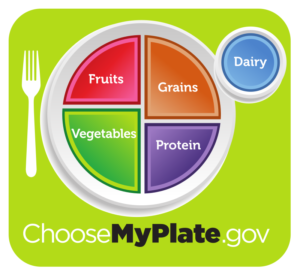MyPlate Oklahoma
MyPlate is the current nutrition guide published by the USDA and the guiding light for nutrition recommendations. Most remember the Food Pyramid. MyPlate was created to depict a place setting that helps better visualize our food groups easier than the previous pyramid.
 A place setting with a plate and glass divided into five food groups approximately:
A place setting with a plate and glass divided into five food groups approximately:
- 30 percent of grains
- 40 percent of vegetables
- 10 percent of fruits
- 20 percent protein
- Dairy, such as a glass of milk or a yogurt cup
This is a helpful visual to fit your diet whether or not it consists of animal proteins or not.
Locally produced MyPlate Oklahoma Foods
- Fruit
- Apricots Blackberries Blueberries (tame and wild) Muskmelons Cherries (sweet and tart) Figs Nectarines Peaches Pears Persimmons Watermelons
- {{content-2}}
- Vegetables
- Asparagus Beans (snap) Beets Cabbage (head) Carrots Eggplant Mustard Greens Okra Potatoes Pumpkins Radishes Spinach Sweet Corn Turnip Greens Turnips
- {{content-2}}
- Grains
- Barley Corn for grain (e.g., flour) Oats Rye Wheat
- {{content-2}}
- Proteins
- Beans (other than lima beans) Beef Bison Catfish Chicken Cowpeas Duck Eggs Elk Emu Goat Goose Lamb Ostrich Partridge Peanuts Peas Pecans Pheasant Pork Quail Rabbit Sesame Seeds Soybeans Sunflower Seeds Tilapia Turkey Venison Walnuts
- {{content-2}}
- Dairy
- Milk, Milk from sheep and goats
- {{content-2}}
KD
